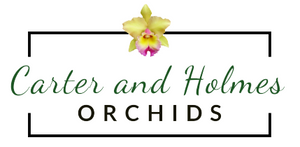Psychopsis papillio Care Sheet

Oncidium papilio (Psychopsis) and its hybrids have a few preferences that when met will increase the strength of the plants and give you more flowers of higher quality. Flowers of the standard color form are bronze and gold and very reminiscent of a butterfly, hence the nickname. The rare alba form is that which flowers as yellow and cream. Bloom stems are sequential, and flowers are produced generally one at a time with the future buds maturing behind the current bloom.
POTTING MEDIA
The roots on these plants will not tolerate sour conditions, but the plants do not like to be repotted frequently. Using a rapidly draining mix will add to the length of time you can keep the plants in the same container. When you do repot, do so in the spring when new roots appear. This may come at the same time as new spikes. Removing spikes when repotting will allow the plant to use more of its energy to get established in its new container. We have had some success using our cypress mulch or Douglas fir based mix and plastic pots though any snug fitting container is best and should be combined with a very fast draining media that does not decompose rapidly. We are currently using a new form of tree fern fiber with great success.
REPOTTING
Some growers suggest leaving the plant bare root before repotting to allow disturbed roots to heal and new roots to form. After removing the plant from its container, soaking it in a solution of Superthrive, Dyna-Grow KLN or another root growth stimulant for a few hours and then allowing it to dry somewhat for a couple of weeks out of mix before repotting it should help initiate sufficient new root growth. During this period the plant should be misted on clear, sunny mornings, but not watered otherwise. This reduction in water encourages new root growth. While undergoing this process watch for signs of stress, or leaf dehydration.
When you do repot, take care to get the crown of the plant just below the potting mix line so that the roots emerge into the mix, not into the air. The plant should be firmly settled into the mix so that it does not "wobble" at all.
WATERING AND FERTILIZING
Water lightly after the repotting stage to prevent fungal or bacterial infections, both of which are inhibited by dryer conditions. We suggest misting daily when weather allows, with slightly heavier watering on occasion to promote humidity around the roots. Once new roots have taken hold in the fresh media less misting may be needed. Fertilize most heavily when in growth (once every 3rd or 4th watering), and heavier when growing in brighter light, but do take care to keep fertilizer deposits from gathering in the crease of emerging growths. A balanced fertilizer of 20-10-20 or 7-8-6 is appropriate.
AIR AND HUMIDITY
Good air movement is essential to help your plants dry faster between watering and will also help to prevent the stale, humid atmosphere in which dangerous pathogens thrive. High humidity in the air is especially beneficial but makes good air movement even more important. If the air is humid, you will have to water a bit less frequently, but do not think of humid air as a substitute for water to the roots when the mix dries out.
LIGHT

Psychopsis papilio and its hybrids grow and flower well for us in moderate light, but some growers report better results in Cattleya-bright light. Brighter light should always be accompanied by more air flow to prevent leaf stress or burn. Too low light and your foliage will be a dark green and show very little pigmentation. Too bright and yellow to red coloring will indicate damage.

